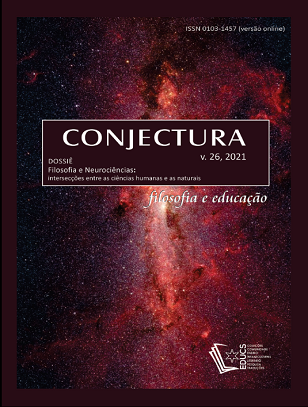An epistemic analysis to elucidate the cryptic species complex
DOI:
https://doi.org/10.18226/21784612.v26.e021005Abstract
Historically, taxonomy, which is the area responsible for
describing new species, used a priori only morphological characteristics.
Darwin (1872) already pointed out that there was a great divergence
among taxonomists when they classified some organism as a species.
When a new species is described, due to its historical weight, the
morphological characters are considered as the first species demarcation
criterion, however, with the advance of genetics and molecular biology,
new methods are added. The use of multiple methods seems to be
necessary for us to develop a contemporary taxonomy, so, a little more
than a decade ago, the “integrative taxonomy” emerged, which refers to
a taxonomy that aims to integrate all available data sources to frame the
data. species limits. Data integration is not possible, as we do not have the
technological capacity to do so. In view of this, we can interact the data
through interactive taxonomy, which suggests, a way of treating the data under the assumption of different lines of evidence, through which the explanations have logical consequences that can be tested, mitigating the subjectivity of the subject in the process. Data interactions can overlap taxonomic descriptions, as they could encompass different phenomena and problem solving, thereby mitigating subjectivism. Therefore, in different fields, at least two indications would be necessary, which could be contained in two different approaches, one hypothetical and one by estimation. Such interpellations would contain evidence with different assumptions and dissimilar data characteristics, thus increasing the number of evidence, as well as improving the reliability of the argument. In this way, we can bring new species to light with a more objective bias and with less likelihood of error.
Keywords: Taxonomy. Cryptic species. Estimation. Hypothetical.
References
ANDREWS, Larry. Language exploration and awareness: A resource book for teachers. Routledge, 2013.
ANDERSON, D.; BURNHAM, K. Model selection and multi-model inference. Second. NY: Springer-Verlag, v. 63, 2004.
CAI, Tianlong et al. Near-complete phylogeny and taxonomic revision of the world’s babblers (Aves: Passeriformes). Molecular phylogenetics and evolution, v. 130, p. 346-356, 2019.
CHRISTOFF, Alexandre U. et al. A new species of Juliomys (Rodentia, Cricetidae, Sigmodontinae) from the Atlantic Forest of southern Brazil. Journal of Mammalogy, v. 97, n. 5, p. 1469-1482, 2016.
DAYRAT, Benoit. Towards integrative taxonomy. Biological journal of the Linnean society, v. 85, n. 3, p. 407-417, 2005.
D'ELÍA, Guillermo et al. Definition and diagnosis of a new tribe of sigmodontine rodents (Cricetldae: Sigmodontinae), and a revised classification of the subfamily. Gayana, v. 71, n. 2, p. 187-194, 2007.
DE QUEIROZ, Kevin. Ernst Mayr and the modern concept of species. Proceedings of the National Academy of Sciences, v. 102, n. suppl 1, p. 6600-6607, 2005.
DE QUEIROZ, Kevin. Species concepts and species delimitation. Systematic biology, v. 56, n. 6, p. 879-886, 2007.
GUARINO, Nicola (Ed.). Formal ontology in information systems: Proceedings of the first international conference (FOIS'98), June 6-8, Trento, Italy. IOS press, 1998.
GRUBER, Thomas R. A translation approach to portable ontology specifications. Knowledge acquisition, v. 5, n. 2, p. 199-220, 1993.
GRUBER, Thomas R. Toward principles for the design of ontologies used for knowledge sharing?. International journal of human-computer studies, v. 43, n. 5-6, p. 907-928, 1995.
HAKIMPOUR, Farshad; GEPPERT, Andreas. Resolving semantic heterogeneity in schema integration. In: Proceedings of the international conference on Formal Ontology in Information Systems-Volume 2001. ACM, 2001. p. 297-308.
HILLER, Rafael Francisco; ALLGAYER, Heloisa. O princípio de transferência em Karl R. Popper. Problemata: Revista Internacional de Filosofía, v. 5, n. 1, p. 182-203, 2014.
KUHN, Thomas. A estrutura das revoluções científicas. São Paulo. 2003.
MAUTNER, Thomas; MAUTNER, Thomas. The Penguin dictionary of philosophy. Penguin Books, 1997.
MAYR, Ernst. Biologia, ciência única. Editora Companhia das Letras, 2005.
MAYR, Ernest. Populações, espécies e evolução. 1977.
MCGUINNESS, Deborah L. et al. An environment for merging and testing large ontologies. In: KR. 2000. p. 483-493.
MORITZ, Craig; SCHNEIDER, Christopher J.; WAKE, David B. Evolutionary relationships within the Ensatina eschscholtzii complex confirm the ring species interpretation. Systematic biology, v. 41, n. 3, p. 273-291, 1992
PADIAL, José M. et al. The integrative future of taxonomy. Frontiers in zoology, v. 7, n. 1, p. 16, 2010.
PALMA, R. Eduardo; RODRÍGUEZ‐SERRANO, Enrique. Systematics of Oligoryzomys (Rodentia, Cricetidae, Sigmodontinae) from southern Chilean Patagonia, with the description of a new species. Journal of Zoological Systematics and Evolutionary Research, v. 56, n. 2, p. 280-299, 2018.
PEIRCE, Charles Sanders. A syllabus of certain topics of logic. 1903.
PEIRCE, Charles Sanders; RUIZ-WERNER, Juan Martin. Deducción, inducción e hipótesis. Buenos Aires: Aguilar, 1970.
POPPER, Karl R. A lógica da pesquisa científica. Editora Cultrix, 2004.
SAMADI, Sarah; BARBEROUSSE, Anouk. The tree, the network, and the species. Biological Journal of the Linnean Society, v. 89, n. 3, p. 509-521, 2006.
SCHLICK-STEINER, Birgit C. et al. Integrative taxonomy: a multisource approach to exploring biodiversity. Annual review of entomology, v. 55, p. 421-438, 2010.
SHETH, Amit P.; LARSON, James A. Federated database systems for managing distributed, heterogeneous, and autonomous databases. ACM Computing Surveys (CSUR), v. 22, n. 3, p. 183-236, 1990.
SOWA, John F. Top-level ontological categories. International journal of human-computer studies, v. 43, n. 5-6, p. 669-685, 1995.
WANG, Q.-M. et al. Multigene phylogeny and taxonomic revision of yeasts and related fungi in the Ustilaginomycotina. Studies in Mycology, v. 81, p. 55-83, 2015.
WILL, Kipling W.; MISHLER, Brent D.; WHEELER, Quentin D. The perils of DNA barcoding and the need for integrative taxonomy. Systematic biology, v. 54, n. 5, p. 844-851, 2005.
YEATES, David K. et al. Integrative taxonomy, or iterative taxonomy?. Systematic entomology, v. 36, n. 2, p. 209-217, 2011.
Downloads
Published
How to Cite
Issue
Section
License
1. The publication of the originals will imply the assignment of copyright to Conjectura Journal.
2. Texts cannot be reproduced without authorization from the Journal after acceptance.









